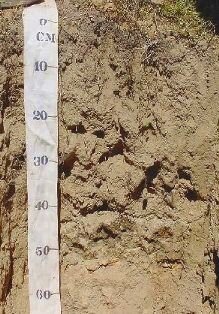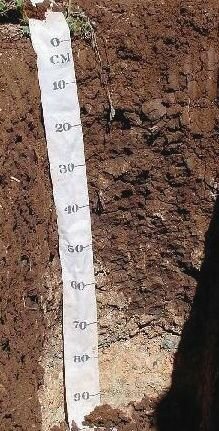Home
Study Sites
Research
Results
Publications
Links
Contacts
Soils Illustrated
The nutrients found within the food that we eat, have their origins in the soil. The plants extract the nutrients to build their tissues from the soil, and we in turn extract nutrients from the plants. The soil is thus crucial to our existence. It is the interface between the living and non-living world. In order for plants to extract water and nutrients from the earth effectively, a suitable soil structure and fertility is required. An ideal soil is well aerated, allows rainwater to infiltrate and contains a store of organic matter.
Of all soil properties, the organic matter or humus is perhaps the most important. It provides the soil with a friable structure that enables effective water and air movement within the soil profile. The humus is also a nutrient store, the equivalent of a slow release fertilizer. Damaging the organic matter of the soil is like damaging a vital organ. Continual ploughing can do exactly this. Ploughing exposes the soil organic matter to oxygen and this leads to its breakdown. Cropping reduces the return of organic matter to the soil. The combination of these two processes results in a drastic reduction in soil organic matter.
Farming practices such as no-till and fertilizing with manures and organic wastes can improve soil organic matter levels and allow the "soil health" to recover.
Soils at the Research Sites
The following pictorial essay highlights some of the ecological differences between the soils at the various study sites.
Bokkeveld Plateau
|
The soils at Nieuwoudtville can be broadly divided between soils that are formed from weathered tillite and those formed from weathered dolerite. The soil profile in this picture is that of a soil derived from tillite. This soil is known as an Estcourt soil. These soils make life rather difficult for plants, because of the impermeable clay layer at about 40 cm. This layer results in regular waterlogging of the soil after heavy rainfalls. Waterlogging results in a lack of oxygen which retards metabolic processes within roots. |
 |
| This picture shows the profile of a soil derived from dolerite. This soil belongs to a group of soils known as vertisols and it is termed an Arcadia soil. The characteristic feature of these soils are the shrinking and swelling of clay minerals, which results in large cracks on the soil surface (see next picture). Such swelling and shrinking causes a process known as self mulching. The soil is like a huge bowl of porridge that is being regularly stirred. The swelling and cracking that occurs in the profile makes burrowing for animals such as mole rats and porcupines rather troublesome. Indeed, porcupines appear to favour the calcareous soils within the vertisols, as they do not shrink and swell to the same extent. |
 |
| Cracks on the surface of the ground caused by the swelling and shrinking of the soil due to clay minerals present. Soils swell when they are wet, and contract when they dry, forming the cracks shown here. |  |
Nama Karoo
|
In Beaufort West, soils tend to have lower horizons (layers) that are rich in calcium. These calcium carbonate layers are termed calcretes. The calcrete forms a hard bank in the soil, which often restricts plant root growth. Aardvarks are surprisingly effective burrowers through calcrete, where strong humans with picks will take a day to dig a hole 1 m deep. The calcrete in some areas is evident on the surface, probably where topsoils have long since eroded away. The calcrete creates a unique soil environment which has a high pH. A unique plant community invariably occurs on these soils. This picture shows a soil profile with a hard carbonate layer near the bottom of the profile. This soil goes by the name of Prieska. |
Drakensberg Sourveld
| In the Underberg region, rainfall is far higher than at the other study sites. The high rainfall results in greater leaching of nutrients from these soils and also creates the red colour of the oxisol soil group. The red colouration is due to a high concentration of iron oxides (rust). Iron oxide formation (as every car owner knows) is stimulated by a combination of water and oxygen (cars at the coast tend to get more of both). These red iron oxides are evident in the profile shown in this picture. The dark band in the profile may be a buried topsoil, as dark soil colours are invariably related to organic carbon. A consequence of the presence of iron oxides is that they absorb phosphate from the soil solution under conditions of low pH. Phosphorus is an essential plant nutrient and the pine plantations in the region are often phosphorus deficient due to the iron grip of the oxides on the phosphates in the soil. |  |
Eastern Cape Thicket Biome
|
In the Eastern Cape, the soils on the dry slopes of the study sites are generally shallow and lie above a hard shale bedrock. These soils have a low infiltration rate and erosion off the slopes is a problem in areas where the soil is exposed to direct raindrop impact (usually areas that are not protected by vegetation). The soil in this picture shows the hard shale bedrock and is termed an Oakleaf soil. Where goats have overgrazed the spekboom veld, soil temperatures reach over 50°C in summer. This reduces soil insect and microbe life with probable consequences for the ecosystem as a whole. |
These pages use CSS style sheets.
If you experience problems viewing them, please turn style sheet support in your browser off, or download a new browser.